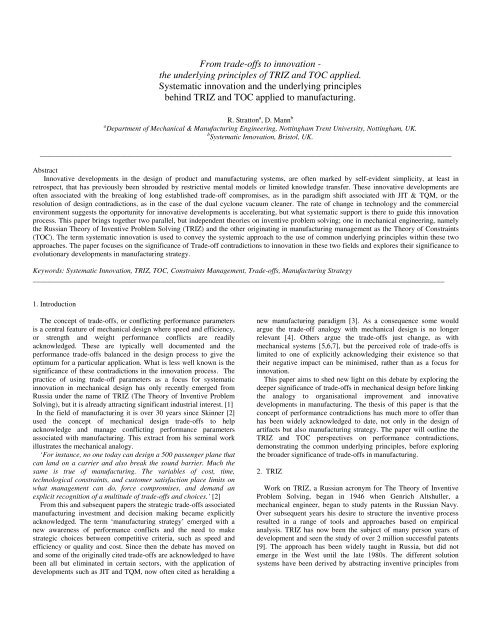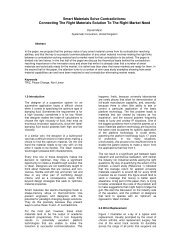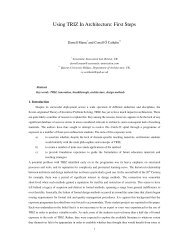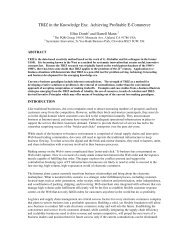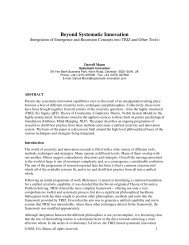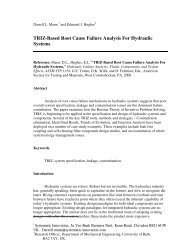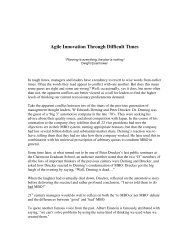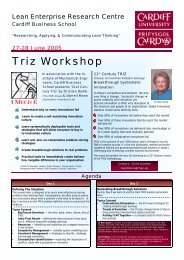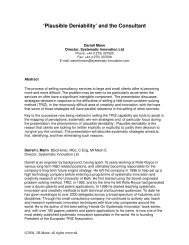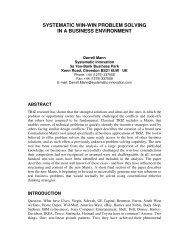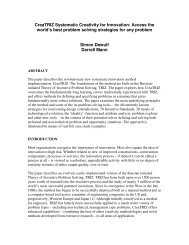From trade-offs to innovation - the underlying principles of TRIZ and ...
From trade-offs to innovation - the underlying principles of TRIZ and ...
From trade-offs to innovation - the underlying principles of TRIZ and ...
Create successful ePaper yourself
Turn your PDF publications into a flip-book with our unique Google optimized e-Paper software.
<strong>From</strong> <strong>trade</strong>-<strong><strong>of</strong>fs</strong> <strong>to</strong> <strong>innovation</strong> -<br />
<strong>the</strong> <strong>underlying</strong> <strong>principles</strong> <strong>of</strong> <strong>TRIZ</strong> <strong>and</strong> TOC applied.<br />
Systematic <strong>innovation</strong> <strong>and</strong> <strong>the</strong> <strong>underlying</strong> <strong>principles</strong><br />
behind <strong>TRIZ</strong> <strong>and</strong> TOC applied <strong>to</strong> manufacturing.<br />
R. Strat<strong>to</strong>n a , D. Mann b<br />
a Department <strong>of</strong> Mechanical & Manufacturing Engineering, Nottingham Trent University, Nottingham, UK.<br />
b Systematic Innovation, Bris<strong>to</strong>l, UK.<br />
_________________________________________________________________________________________________________________<br />
Abstract<br />
Innovative developments in <strong>the</strong> design <strong>of</strong> product <strong>and</strong> manufacturing systems, are <strong>of</strong>ten marked by self-evident simplicity, at least in<br />
retrospect, that has previously been shrouded by restrictive mental models or limited knowledge transfer. These innovative developments are<br />
<strong>of</strong>ten associated with <strong>the</strong> breaking <strong>of</strong> long established <strong>trade</strong>-<strong>of</strong>f compromises, as in <strong>the</strong> paradigm shift associated with JIT & TQM, or <strong>the</strong><br />
resolution <strong>of</strong> design contradictions, as in <strong>the</strong> case <strong>of</strong> <strong>the</strong> dual cyclone vacuum cleaner. The rate <strong>of</strong> change in technology <strong>and</strong> <strong>the</strong> commercial<br />
environment suggests <strong>the</strong> opportunity for innovative developments is accelerating, but what systematic support is <strong>the</strong>re <strong>to</strong> guide this <strong>innovation</strong><br />
process. This paper brings <strong>to</strong>ge<strong>the</strong>r two parallel, but independent <strong>the</strong>ories on inventive problem solving; one in mechanical engineering, namely<br />
<strong>the</strong> Russian Theory <strong>of</strong> Inventive Problem Solving (<strong>TRIZ</strong>) <strong>and</strong> <strong>the</strong> o<strong>the</strong>r originating in manufacturing management as <strong>the</strong> Theory <strong>of</strong> Constraints<br />
(TOC). The term systematic <strong>innovation</strong> is used <strong>to</strong> convey <strong>the</strong> systemic approach <strong>to</strong> <strong>the</strong> use <strong>of</strong> common <strong>underlying</strong> <strong>principles</strong> within <strong>the</strong>se two<br />
approaches. The paper focuses on <strong>the</strong> significance <strong>of</strong> Trade-<strong>of</strong>f contradictions <strong>to</strong> <strong>innovation</strong> in <strong>the</strong>se two fields <strong>and</strong> explores <strong>the</strong>ir significance <strong>to</strong><br />
evolutionary developments in manufacturing strategy.<br />
Keywords: Systematic Innovation, <strong>TRIZ</strong>, TOC, Constraints Management, Trade-<strong><strong>of</strong>fs</strong>, Manufacturing Strategy<br />
_________________________________________________________________________________________________________________<br />
1. Introduction<br />
The concept <strong>of</strong> <strong>trade</strong>-<strong><strong>of</strong>fs</strong>, or conflicting performance parameters<br />
is a central feature <strong>of</strong> mechanical design where speed <strong>and</strong> efficiency,<br />
or strength <strong>and</strong> weight performance conflicts are readily<br />
acknowledged. These are typically well documented <strong>and</strong> <strong>the</strong><br />
performance <strong>trade</strong>-<strong><strong>of</strong>fs</strong> balanced in <strong>the</strong> design process <strong>to</strong> give <strong>the</strong><br />
optimum for a particular application. What is less well known is <strong>the</strong><br />
significance <strong>of</strong> <strong>the</strong>se contradictions in <strong>the</strong> <strong>innovation</strong> process. The<br />
practice <strong>of</strong> using <strong>trade</strong>-<strong>of</strong>f parameters as a focus for systematic<br />
<strong>innovation</strong> in mechanical design has only recently emerged from<br />
Russia under <strong>the</strong> name <strong>of</strong> <strong>TRIZ</strong> (The Theory <strong>of</strong> Inventive Problem<br />
Solving), but it is already attracting significant industrial interest. [1]<br />
In <strong>the</strong> field <strong>of</strong> manufacturing it is over 30 years since Skinner [2]<br />
used <strong>the</strong> concept <strong>of</strong> mechanical design <strong>trade</strong>-<strong><strong>of</strong>fs</strong> <strong>to</strong> help<br />
acknowledge <strong>and</strong> manage conflicting performance parameters<br />
associated with manufacturing. This extract from his seminal work<br />
illustrates <strong>the</strong> mechanical analogy.<br />
‘For instance, no one <strong>to</strong>day can design a 500 passenger plane that<br />
can l<strong>and</strong> on a carrier <strong>and</strong> also break <strong>the</strong> sound barrier. Much <strong>the</strong><br />
same is true <strong>of</strong> manufacturing. The variables <strong>of</strong> cost, time,<br />
technological constraints, <strong>and</strong> cus<strong>to</strong>mer satisfaction place limits on<br />
what management can do, force compromises, <strong>and</strong> dem<strong>and</strong> an<br />
explicit recognition <strong>of</strong> a multitude <strong>of</strong> <strong>trade</strong>-<strong><strong>of</strong>fs</strong> <strong>and</strong> choices.’ [2]<br />
<strong>From</strong> this <strong>and</strong> subsequent papers <strong>the</strong> strategic <strong>trade</strong>-<strong><strong>of</strong>fs</strong> associated<br />
manufacturing investment <strong>and</strong> decision making became explicitly<br />
acknowledged. The term ‘manufacturing strategy’ emerged with a<br />
new awareness <strong>of</strong> performance conflicts <strong>and</strong> <strong>the</strong> need <strong>to</strong> make<br />
strategic choices between competitive criteria, such as speed <strong>and</strong><br />
efficiency or quality <strong>and</strong> cost. Since <strong>the</strong>n <strong>the</strong> debate has moved on<br />
<strong>and</strong> some <strong>of</strong> <strong>the</strong> originally cited <strong>trade</strong>-<strong><strong>of</strong>fs</strong> are acknowledged <strong>to</strong> have<br />
been all but eliminated in certain sec<strong>to</strong>rs, with <strong>the</strong> application <strong>of</strong><br />
developments such as JIT <strong>and</strong> TQM, now <strong>of</strong>ten cited as heralding a<br />
new manufacturing paradigm [3]. As a consequence some would<br />
argue <strong>the</strong> <strong>trade</strong>-<strong>of</strong>f analogy with mechanical design is no longer<br />
relevant [4]. O<strong>the</strong>rs argue <strong>the</strong> <strong>trade</strong>-<strong><strong>of</strong>fs</strong> just change, as with<br />
mechanical systems [5,6,7], but <strong>the</strong> perceived role <strong>of</strong> <strong>trade</strong>-<strong><strong>of</strong>fs</strong> is<br />
limited <strong>to</strong> one <strong>of</strong> explicitly acknowledging <strong>the</strong>ir existence so that<br />
<strong>the</strong>ir negative impact can be minimised, ra<strong>the</strong>r than as a focus for<br />
<strong>innovation</strong>.<br />
This paper aims <strong>to</strong> shed new light on this debate by exploring <strong>the</strong><br />
deeper significance <strong>of</strong> <strong>trade</strong>-<strong><strong>of</strong>fs</strong> in mechanical design before linking<br />
<strong>the</strong> analogy <strong>to</strong> organisational improvement <strong>and</strong> innovative<br />
developments in manufacturing. The <strong>the</strong>sis <strong>of</strong> this paper is that <strong>the</strong><br />
concept <strong>of</strong> performance contradictions has much more <strong>to</strong> <strong>of</strong>fer than<br />
has been widely acknowledged <strong>to</strong> date, not only in <strong>the</strong> design <strong>of</strong><br />
artifacts but also manufacturing strategy. The paper will outline <strong>the</strong><br />
<strong>TRIZ</strong> <strong>and</strong> TOC perspectives on performance contradictions,<br />
demonstrating <strong>the</strong> common <strong>underlying</strong> <strong>principles</strong>, before exploring<br />
<strong>the</strong> broader significance <strong>of</strong> <strong>trade</strong>-<strong><strong>of</strong>fs</strong> in manufacturing.<br />
2. <strong>TRIZ</strong><br />
Work on <strong>TRIZ</strong>, a Russian acronym for The Theory <strong>of</strong> Inventive<br />
Problem Solving, began in 1946 when Genrich Altshuller, a<br />
mechanical engineer, began <strong>to</strong> study patents in <strong>the</strong> Russian Navy.<br />
Over subsequent years his desire <strong>to</strong> structure <strong>the</strong> inventive process<br />
resulted in a range <strong>of</strong> <strong>to</strong>ols <strong>and</strong> approaches based on empirical<br />
analysis. <strong>TRIZ</strong> has now been <strong>the</strong> subject <strong>of</strong> many person years <strong>of</strong><br />
development <strong>and</strong> seen <strong>the</strong> study <strong>of</strong> over 2 million successful patents<br />
[9]. The approach has been widely taught in Russia, but did not<br />
emerge in <strong>the</strong> West until <strong>the</strong> late 1980s. The different solution<br />
systems have been derived by abstracting inventive <strong>principles</strong> from
ongoing analysis <strong>of</strong> patent data. Several <strong>of</strong> <strong>the</strong>se focus on<br />
contradictions or <strong>trade</strong>-<strong><strong>of</strong>fs</strong> in identifying innovative solutions.<br />
The <strong>TRIZ</strong> methodology claims that, ‘Inventive problems can be<br />
codified, classified <strong>and</strong> solved methodically, just like o<strong>the</strong>r<br />
engineering problems’. [8]<br />
There are three premises on which <strong>the</strong> <strong>the</strong>ory is based:<br />
• The ideal design with no harmful functions is a goal.<br />
• An inventive solution involves wholly or partially eliminating a<br />
contradiction.<br />
• The inventive process can be structured.<br />
Each <strong>of</strong> <strong>the</strong>se premises will be dealt with in turn.<br />
2.1 The ideal design with no harmful functions is a goal.<br />
Finding <strong>the</strong> ideal solution <strong>to</strong> a needed effect or function with no<br />
additional resources or negative secondary effects is referred <strong>to</strong> in<br />
<strong>TRIZ</strong> circles as Ideality.<br />
figure 1. Fur<strong>the</strong>r patent work in <strong>the</strong> 60s <strong>and</strong> 70s resulted in <strong>the</strong><br />
percentages shown in figure 1.<br />
Altshuller considered level one solutions <strong>to</strong> not be inventions but<br />
narrow improvements. Level 2 solutions involved partially<br />
eliminating contradiction but still requiring obvious compromises.<br />
Level 3 solutions completely eliminate <strong>the</strong> main contradiction<br />
within <strong>the</strong> existing system using technology outside <strong>the</strong> field. The<br />
level <strong>of</strong> solution can be considered <strong>to</strong> cause a paradigm shift within<br />
<strong>the</strong> industry as <strong>the</strong> solution is outside <strong>the</strong> industry’s range <strong>of</strong><br />
accepted ideas <strong>and</strong> <strong>principles</strong>.<br />
Level 4 solutions are found in science <strong>and</strong> are outside <strong>the</strong><br />
technology’s normal paradigm, involving a completely different<br />
principle.<br />
Level 5 solutions lie beyond <strong>the</strong> confines <strong>of</strong> contemporary<br />
scientific knowledge.<br />
Altshuler claimed his solution systems could assist <strong>innovation</strong> at<br />
levels 2-4.<br />
Ideality =<br />
All useful effects or functions<br />
All harmful effects or functions<br />
2.3 The inventive process can be structured.<br />
The ideal being, <strong>to</strong> achieve all useful effects or functions with no<br />
harmful effects or any use <strong>of</strong> resource. One can argue <strong>the</strong>re is little<br />
new in this, as a similar emphasis on improving functionality is also<br />
evident in widely established approaches such as Value Engineering.<br />
However, <strong>the</strong> difference is that this thinking is central <strong>to</strong> <strong>TRIZ</strong> <strong>and</strong><br />
specialist supporting <strong>to</strong>ols have been developed that specifically<br />
concentrate on improving <strong>the</strong> functionality through <strong>innovation</strong> ra<strong>the</strong>r<br />
than <strong>the</strong> traditional cost cutting focus <strong>of</strong> Value Analysis.<br />
Generic Problem<br />
Category<br />
Classification<br />
Correlation<br />
Opera<strong>to</strong>rs<br />
Generic Solution<br />
Category<br />
Classification<br />
2.2 An inventive solution involves wholly or partially eliminating a<br />
contradiction.<br />
Specific Problem<br />
Specific solution<br />
Altshuller’s [9,p12] early work on patents resulted in him<br />
classifying inventive solutions in<strong>to</strong> five levels. Through this work he<br />
defined an inventive problem as one containing at least one<br />
contradiction. After reviewing 200,000 patent abstracts he selected<br />
40,000 as representative <strong>of</strong> inventiveness. The remainder he<br />
considered <strong>to</strong> involve self evident direct improvements. He <strong>the</strong>n<br />
separated <strong>the</strong> 40,000 inventive solutions in<strong>to</strong> five levels as shown in<br />
Levels <strong>of</strong> Solution<br />
• Level 1: Conventional Solution: 32%<br />
• Solutions by methods well known within specialty<br />
• Level 2: Small invention inside paradigm: 45%<br />
• improvement <strong>of</strong> an existing system, usually with some compromise.<br />
• Level 3: Invention inside technology: 19%<br />
• essential improvement <strong>of</strong> existing system<br />
• Level 4: Invention outside Technology: 4%<br />
• New generation <strong>of</strong> a design, using science not technology.<br />
• Level 5: Discovery:
Generic Problem<br />
(technical<br />
contradictions)<br />
Classification<br />
Contradiction<br />
Matrix<br />
Generic Solution<br />
(40 <strong>principles</strong>)<br />
Specialisation<br />
Generic Problem<br />
(physical<br />
contradictions)<br />
Classification<br />
Separation<br />
Principles<br />
Generic Solutions<br />
(Selected separation<br />
Principles)<br />
Specialisation<br />
Specific Problem<br />
Specific solution<br />
Figure 3: Use <strong>of</strong> <strong>the</strong> general case applied <strong>to</strong> technical<br />
contradictions<br />
Generic Problem<br />
(technical<br />
contradictions)<br />
Classification<br />
Contradiction<br />
Matrix<br />
Generic Solutions<br />
(Selected from 40<br />
<strong>principles</strong>)<br />
Specialisation<br />
Trial & error<br />
Specific Problem<br />
Specific solution<br />
contradiction would be <strong>to</strong> relate <strong>the</strong> <strong>trade</strong>-<strong>of</strong>f parameters <strong>to</strong> <strong>the</strong> 39<br />
st<strong>and</strong>ard technical contradiction parameters <strong>to</strong> find <strong>the</strong> closest match.<br />
In this case <strong>the</strong>re is an exact match Speed (parameter 9) <strong>and</strong><br />
Adaptability (parameter 35). The contradiction table developed by<br />
Altshuller recommends 3 <strong>of</strong> <strong>the</strong> 40 <strong>principles</strong> (<strong>principles</strong> 15, 10 &<br />
26) for early consideration. Principle 15 is ‘dynamicity’ which is<br />
illustrated with various examples that can be linked <strong>to</strong> <strong>the</strong> concept <strong>of</strong><br />
variable wing geometry as a possible solution. This would have<br />
classified as a level 3 solution.<br />
These 40 inventive <strong>principles</strong> <strong>and</strong> <strong>the</strong> contradiction matrix have<br />
s<strong>to</strong>od <strong>the</strong> test <strong>of</strong> time, however this was only <strong>the</strong> first <strong>of</strong> <strong>the</strong> <strong>TRIZ</strong><br />
solutions systems.<br />
2.3.1 Physical Contradiction Solution System<br />
Over a period <strong>of</strong> time Altshuller identified a fur<strong>the</strong>r level <strong>of</strong><br />
abstraction from <strong>the</strong> technical contradictions. He found that in many<br />
cases <strong>the</strong> technical contradiction or <strong>trade</strong>-<strong>of</strong>f could be presented as<br />
two extremes <strong>of</strong> one feature, which he called a Physical<br />
Contradiction. Put more formally: A Physical Contradiction requires<br />
mutually exclusive states as <strong>the</strong>y relate <strong>to</strong> a function, performance or<br />
a component. Figure 4 illustrates <strong>the</strong> higher level <strong>of</strong> abstraction<br />
Fig 4 :The second level <strong>of</strong> abstraction<br />
In <strong>the</strong> figure a technical contradiction between parameters A & B has<br />
been fur<strong>the</strong>r abstracted <strong>to</strong> present <strong>the</strong> contradiction in terms <strong>of</strong> a<br />
common variable parameter C, which represents <strong>the</strong> physical<br />
contradiction. Altshuller found that by defining <strong>the</strong> contradiction<br />
around one parameter with mutually exclusive states <strong>the</strong> correlation<br />
opera<strong>to</strong>rs used <strong>to</strong> detect a solution could be more generic <strong>and</strong> <strong>the</strong>re<br />
are just four separation <strong>principles</strong> used <strong>to</strong> help resolve this type <strong>of</strong><br />
contradiction.<br />
These Separation Principles can be summarised as:<br />
Separation <strong>of</strong> opposite requirements in space;<br />
Separation <strong>of</strong> opposite requirements in time;<br />
Separation within a whole <strong>and</strong> its parts;<br />
Separation upon condition.<br />
If we consider <strong>the</strong> aircraft example again, this development would<br />
take <strong>the</strong> original Technical Contradictions <strong>of</strong> speed <strong>and</strong> adaptability<br />
<strong>and</strong> look for ano<strong>the</strong>r common parameter displaying mutually<br />
exclusive states, as displayed in figure 5. Such a parameter in this<br />
example might be wing area. For speed a small wing area is<br />
required, but for take-<strong>of</strong>f, l<strong>and</strong>ing <strong>and</strong> general manoeuvrability a<br />
larger wing area is required. The four Separation Principles would<br />
<strong>the</strong>n be considered <strong>and</strong> in this case ‘separation in time’ naturally<br />
leads <strong>to</strong> <strong>the</strong> possible option <strong>of</strong> variable wing geometry.<br />
Parameter A<br />
Physical contradiction<br />
Technical<br />
Contradiction<br />
Parameter B<br />
2.4 Conclusion<br />
These two solution systems represent <strong>the</strong> founding work <strong>of</strong> <strong>TRIZ</strong><br />
centred on contradictions. For a more comprehensive introduction<br />
see [9] or for more depth [10,11]. Having introduced <strong>the</strong> innovative<br />
role <strong>of</strong> <strong>trade</strong>-<strong><strong>of</strong>fs</strong> in mechanical design let us now look at <strong>the</strong> related<br />
aspects <strong>of</strong> TOC <strong>and</strong> distill out some <strong>of</strong> <strong>the</strong> common <strong>principles</strong> with<br />
manufacturing examples.<br />
Parameter C<br />
Figure 5: A graphical representation <strong>of</strong> technical<br />
<strong>and</strong> physical contradictions<br />
associated with <strong>the</strong> Physical Contradiction solution systems.<br />
Typical physical contradictions include: fast vs. slow; hard vs. s<strong>of</strong>t;<br />
solid vs. porous; heavy vs. light; moveable vs. stationary; dark vs.<br />
light; hot vs. cold; big vs. small; etc.<br />
The relationship between <strong>the</strong> Technical <strong>and</strong> Physical<br />
Contradictions can be viewed graphically as illustrated in Figures 5.<br />
3. TOC<br />
The Theory <strong>of</strong> Constraints has been developing over 20 years by<br />
Dr E Goldratt <strong>and</strong> from 1986 within <strong>the</strong> Arhaham Goldratt Institute<br />
(AGI), an international partnership. There are also independent user<br />
groups actively involved in <strong>the</strong> work, <strong>the</strong> most notable <strong>of</strong> which is<br />
<strong>the</strong> America Production & Inven<strong>to</strong>ry Control Society (APICS)<br />
Constraint Management Special Interest Group. [12]<br />
TOC as with <strong>TRIZ</strong> is also focused on developing innovative<br />
solutions, but in this case <strong>the</strong> focus is on managing or breaking
constraints within organisations. It originated with <strong>the</strong> development<br />
<strong>of</strong> Optimised Production Technology (OPT), a revolutionary<br />
computerised planning <strong>and</strong> control system <strong>of</strong> <strong>the</strong> 1980s, which is<br />
now considered a seminal development in Advanced Planning <strong>and</strong><br />
Scheduling (APS) systems [13]. Since <strong>the</strong> mid1980s <strong>the</strong> <strong>principles</strong><br />
have been applied <strong>to</strong> addressing not only physical constraints, but<br />
also policy <strong>and</strong> paradigm constraints within organisations. A recent<br />
application <strong>of</strong> this work <strong>to</strong> conflicts associated with project<br />
management has resulted in <strong>the</strong> generic solution <strong>of</strong> Critical Chain<br />
Project Management, which is becoming widely acknowledged by<br />
industry [14]. In addition <strong>to</strong> <strong>the</strong> development <strong>of</strong> <strong>the</strong>se generic<br />
solutions <strong>the</strong>re has been <strong>the</strong> parallel activity <strong>of</strong> developing a practical<br />
improvement process, <strong>to</strong> which Goldratt attributes his generic<br />
solutions. This process centres on identifying <strong>and</strong> eliminating policy<br />
or paradigm constraints, which are closely associated with <strong>trade</strong>-<strong>of</strong>f<br />
conflicts. There are two basic <strong>to</strong>ols used in this process, one is used<br />
<strong>to</strong> maps cognition through Effect-Cause-Effect (ECE) analysis, <strong>and</strong><br />
<strong>the</strong> o<strong>the</strong>r is used <strong>to</strong> expose <strong>and</strong> break <strong>the</strong> core conflict or constraint<br />
through <strong>the</strong> Evaporating Clouds (EvC) technique. As with <strong>TRIZ</strong>,<br />
TOC is very much industry led, but <strong>the</strong> <strong>the</strong>oretical base is evident in<br />
that it has enabled <strong>the</strong> generic solutions <strong>to</strong> be developed over <strong>the</strong> past<br />
15 years [15].<br />
3.2 Opportunity for value-adding improvement is limited by few<br />
constraints.<br />
The TOC defines a constraint as, ‘Anything that prevents <strong>the</strong><br />
organisation from achieving higher performance versus its goal’. So<br />
in <strong>the</strong> case <strong>of</strong> a pr<strong>of</strong>it making organisation this centres on what limits<br />
T. The TOC claim is that <strong>the</strong>re are few constraints <strong>to</strong> any system<br />
preventing it from achieving its goal.<br />
Although TOC originally focused on physical resource constraints<br />
<strong>the</strong> <strong>underlying</strong> constraints are commonly <strong>underlying</strong> policy, or<br />
deeper paradigm constraints. TOC uses cognitive mapping <strong>to</strong> verify<br />
this assumption where necessary, but <strong>the</strong>re are many o<strong>the</strong>r authors<br />
who acknowledge <strong>the</strong> importance <strong>of</strong> <strong>underlying</strong> core problems that<br />
constrain system improvement. Senge refers <strong>to</strong> <strong>the</strong> need <strong>to</strong> tackle<br />
<strong>underlying</strong> ‘mental models’ [16] <strong>and</strong> Argyris refers <strong>to</strong> <strong>the</strong> need for<br />
double-loop-learning where <strong>the</strong> deep-seated ‘governing variable’<br />
[17] are restricting organisational improvement.<br />
As with <strong>TRIZ</strong> <strong>the</strong>se constraining core problems are exposed as<br />
contradicting requirements that o<strong>the</strong>rwise tend <strong>to</strong> be ignored or<br />
accommodated via local sub-optimisation models.<br />
The <strong>underlying</strong> premises behind TOC :<br />
• All organisations have a purpose or goal <strong>the</strong>y aspire <strong>to</strong><br />
continually move <strong>to</strong>wards.<br />
• Opportunity for value adding improvement is limited by few<br />
constraints.<br />
• Identifying <strong>and</strong> breaking <strong>the</strong>se constraints can be structured.<br />
Cost/Unit<br />
Total costs<br />
Inven<strong>to</strong>ry<br />
carrying costs<br />
3.1 All organisations have a purpose or goal <strong>the</strong>y aspire <strong>to</strong><br />
continually move <strong>to</strong>wards.<br />
As <strong>TRIZ</strong> focuses on improving <strong>the</strong> functionality with minimum<br />
waste, TOC focuses on improving <strong>the</strong> value adding performance <strong>of</strong><br />
<strong>the</strong> organisation ra<strong>the</strong>r than reducing cost. Where <strong>the</strong> organisation is<br />
for-pr<strong>of</strong>it <strong>the</strong> term Throughput (T) is used <strong>to</strong> identify <strong>the</strong> financial<br />
value added component <strong>and</strong> Operating Expense (OE) is used <strong>to</strong><br />
cover all o<strong>the</strong>r expenses.<br />
Throughput (T) = Sales -Direct materials <strong>and</strong> directly varialble costs.<br />
Operating Expense (OE) = all o<strong>the</strong>r operating costs.<br />
Therefore<br />
Net pr<strong>of</strong>it = T-OE<br />
Or<br />
Value Added Productivity = T/OE<br />
As with <strong>the</strong> Ideality ratio <strong>of</strong> <strong>TRIZ</strong> <strong>the</strong> statement is not original, but<br />
<strong>the</strong> focus with <strong>the</strong> support <strong>to</strong>ols is. TOC centres on increasing<br />
Throughput ra<strong>the</strong>r than reducing Operating Expense; arguing that<br />
although cost cutting is important it is limited <strong>and</strong> can be dangerous<br />
without a strategic perspective. Focusing on increased Throughput is<br />
inevitably strategic in nature requiring a systems view <strong>of</strong> <strong>the</strong><br />
business <strong>to</strong> enable <strong>the</strong> identity <strong>of</strong> what limits or constrains current<br />
<strong>and</strong> future Throughput.<br />
The focus on ‘goal units’ is also widely applied <strong>to</strong> non-pr<strong>of</strong>it making<br />
organisations, but <strong>the</strong> unit <strong>of</strong> measure is not so convenient in <strong>the</strong>se<br />
cases.<br />
EBQ<br />
Set-up cost<br />
Batch size<br />
Figure 7 Traditional Batch Size Conflict<br />
A classic example <strong>of</strong> this is evident in <strong>the</strong> Economic Batch<br />
Quantity (EBQ) formula graphically illustrated in figure 7. As can be<br />
seen <strong>the</strong> traditional batching policy represented by this simple model<br />
reflects <strong>the</strong> conflicting parameters in a similar way <strong>to</strong> <strong>TRIZ</strong> Physical<br />
Contradictions. This is a classic example <strong>of</strong> a <strong>trade</strong>-<strong>of</strong>f compromise<br />
viewed very narrowly with many embedded assumptions, which<br />
have proved <strong>to</strong> be increasingly invalid. However, such models<br />
represented a paradigm that has had wide implications in<br />
manufacturing management <strong>and</strong> <strong>the</strong>re is a similar model for quality<br />
costs. JIT <strong>and</strong> TQM developments challenged <strong>the</strong> validity <strong>of</strong> such<br />
models in <strong>the</strong> 1980s demonstrating how <strong>the</strong>y could be broken, <strong>and</strong><br />
resulting in a paradigm shift in manufacturing management thinking.<br />
It is clearly evident that <strong>the</strong> <strong>TRIZ</strong> concept <strong>of</strong> Physical Contradictions<br />
is closely related <strong>and</strong> this will be illustrated later.<br />
3.3 Identifying <strong>and</strong> breaking <strong>the</strong>se constraints can be structured.<br />
TOC <strong>and</strong> <strong>TRIZ</strong> actively seek out such compromises with a view <strong>to</strong><br />
focusing attention on a critical area <strong>of</strong> <strong>the</strong> system <strong>and</strong> so enabling<br />
overall systems improvement. Typically <strong>the</strong> contradiction, or conflict<br />
<strong>of</strong> major concern would be verified by a form <strong>of</strong> cause <strong>and</strong> effect<br />
analysis in both TOC <strong>and</strong> <strong>TRIZ</strong> [18].
In TOC <strong>the</strong> contradiction is presented in what is called an<br />
Evaporating Cloud (EvC), sometimes known as a Conflict<br />
Resolution Diagram. The diagram is a simplified cause <strong>and</strong> effect<br />
diagram used <strong>to</strong> expose <strong>and</strong> challenge <strong>the</strong> <strong>underlying</strong> logic linking<br />
conflicting needs. The cloud depicting <strong>the</strong> batch size conflict is<br />
illustrated in fig. 8.<br />
<strong>principles</strong>. If we apply <strong>the</strong> principle <strong>of</strong> ‘separate in time’ <strong>the</strong><br />
opportunity <strong>to</strong> distinguish between process <strong>and</strong> transfer batches<br />
becomes evident. Earlier work by <strong>the</strong> authors’ [18] has explored<br />
<strong>the</strong>se parallels more closely.<br />
3.3.1 The breaking <strong>of</strong> paradigm constraints<br />
Objective<br />
A<br />
Save<br />
cost-per-part<br />
Requirements<br />
B<br />
Save set-up<br />
cost per unit<br />
Pre-requisites<br />
D<br />
Enlarge <strong>the</strong><br />
batch size<br />
Objective<br />
A<br />
Run production<br />
effectively<br />
Requirements<br />
B Don’t turn a<br />
non-bottleneck<br />
in<strong>to</strong> a bottleneck<br />
Pre-requisites<br />
D<br />
Enlarge <strong>the</strong><br />
batch size<br />
C<br />
Save carrying<br />
cost per unit<br />
Figure 8 Batch Size Cloud<br />
D’<br />
Reduce <strong>the</strong><br />
batch size<br />
C Reduce<br />
production<br />
lead-time<br />
D’<br />
Reduce <strong>the</strong><br />
batch size<br />
Figure 9 Batch Size Cloud in <strong>the</strong> Throughput World [20]<br />
In <strong>the</strong> diagram, <strong>the</strong> requirements B&C are necessary (but not<br />
sufficient) <strong>to</strong> achieve <strong>the</strong> objective A. Similarly <strong>the</strong> prerequisites at<br />
D <strong>and</strong> D’ are necessary (but not sufficient) <strong>to</strong> achieve <strong>the</strong><br />
requirements at B <strong>and</strong> C respectively. It is normal with <strong>the</strong> EvC <strong>to</strong><br />
formulate <strong>the</strong> problem from <strong>the</strong> prerequisite conflict <strong>and</strong> <strong>to</strong> <strong>the</strong>n<br />
work from <strong>the</strong>re, clarifying <strong>the</strong> thinking behind <strong>the</strong> causal links<br />
along <strong>the</strong> way, through B, C <strong>and</strong> finally A. This is however usually<br />
an iterative process.<br />
Each <strong>of</strong> <strong>the</strong> arrows in <strong>the</strong> diagram is <strong>the</strong>n scrutinised during a<br />
TOC analysis <strong>of</strong> <strong>the</strong> problem situation <strong>to</strong> examine <strong>the</strong> assumptions<br />
contained in <strong>the</strong> problem definition. In TOC terms, <strong>the</strong> Cloud is<br />
evaporated (i.e. <strong>the</strong> problem is solved) if one <strong>of</strong> <strong>the</strong> assumptions<br />
embodied in <strong>the</strong> arrow can in some way be invalidated.<br />
By way <strong>of</strong> example, both JIT <strong>and</strong> TOC have challenge <strong>the</strong><br />
assumption contained in <strong>the</strong> arrow B-D, that large batches are a<br />
prerequisite for reducing set-up costs. Therefore, if means are found<br />
<strong>to</strong> break <strong>the</strong> perceived relationship <strong>the</strong>n <strong>the</strong> problem is solved.<br />
The JIT approach <strong>to</strong> this problem was <strong>to</strong> challenge <strong>the</strong><br />
assumption that set-up times were cast in s<strong>to</strong>ne. The wider benefits<br />
<strong>of</strong> low inven<strong>to</strong>ry <strong>and</strong> <strong>the</strong> opportunity <strong>to</strong> simply reduce set-up time<br />
was a revelation <strong>to</strong> many industrialists <strong>and</strong>, in some cases,<br />
effectively eliminated <strong>the</strong> conflict at source with little expense.<br />
The traditional TOC challenge <strong>to</strong> this arrow relates <strong>to</strong> <strong>the</strong><br />
<strong>underlying</strong> performance measurement systems that assume that<br />
increasing <strong>the</strong> number <strong>of</strong> set-ups au<strong>to</strong>matically means increased<br />
Operating Expense or reduced Throughput. In reality <strong>the</strong>re is <strong>of</strong>ten<br />
spare capacity that results in nei<strong>the</strong>r increased cost nor reduced<br />
Throughput. But more importantly <strong>the</strong> impact on T & OE needs <strong>to</strong><br />
be clearly distinguished <strong>and</strong> located if appropriate action is <strong>to</strong> follow.<br />
This particular cloud has also been broken at <strong>the</strong> D-D’ conflict<br />
arrow. The false assumption is that <strong>the</strong>re is only one definition <strong>of</strong><br />
‘batch’, but <strong>the</strong> two requirements put different interpretations on <strong>the</strong><br />
word. The conflict can be evaporated, at least in some cases by<br />
acknowledging <strong>the</strong> distinction between a process batch <strong>and</strong> a transfer<br />
batch.<br />
The breaking <strong>of</strong> <strong>the</strong> arrow at D-D’ is closely related <strong>to</strong> <strong>the</strong><br />
breaking <strong>of</strong> a <strong>TRIZ</strong> Physical Contradiction using <strong>the</strong> four separation<br />
The breaking <strong>of</strong> clouds at arrow B-D or C-D’ typically represents <strong>the</strong><br />
breaking <strong>of</strong> a policy constraint, but <strong>the</strong> work <strong>of</strong> JIT, TQM <strong>and</strong> TOC<br />
went fur<strong>the</strong>r than this. It can be argued that <strong>the</strong> batch size cloud is<br />
built around a ‘costing paradigm’ particularly prevalent in <strong>the</strong> West<br />
<strong>and</strong> graphically illustrated by Skinner in The Productivity Paradox<br />
[19]. Here Skinner’s case work illustrates how many American<br />
companies in <strong>the</strong> 1980s were focusing on a very narrow <strong>and</strong><br />
declining perception <strong>of</strong> productivity, direct labour productivity, <strong>and</strong><br />
not considering <strong>the</strong> impact <strong>of</strong> <strong>the</strong>ir direct labour cost focus on <strong>the</strong><br />
loss <strong>of</strong> orders through <strong>the</strong> <strong>trade</strong>-<strong>of</strong>f with service <strong>and</strong> quality.<br />
If we consider <strong>the</strong> concept <strong>of</strong> evaporating clouds <strong>the</strong> breaking <strong>of</strong> a<br />
paradigm constraint will tend <strong>to</strong> be at a more fundamental location<br />
such as arrows A-B or A-C. In <strong>the</strong> case <strong>of</strong> this cloud <strong>the</strong> stated<br />
objective is also embedded in <strong>the</strong> costing paradigm, which Goldratt<br />
refers <strong>to</strong> as <strong>the</strong> ‘Cost World’ [20].<br />
Figure 9 is <strong>the</strong> version <strong>of</strong> <strong>the</strong> cloud advocated by TOC, which<br />
redefines <strong>the</strong> objective <strong>and</strong> requirements. Objective C now more<br />
clearly reflects <strong>the</strong> impact on cus<strong>to</strong>mer service <strong>and</strong> <strong>the</strong>refore future<br />
Throughput, whilst objective B reflects <strong>the</strong> need <strong>to</strong> consider<br />
available capacity <strong>and</strong> <strong>the</strong>refore <strong>the</strong> possibility <strong>of</strong> constraining<br />
current Throughput. This redraw <strong>of</strong> <strong>the</strong> cloud reflects <strong>the</strong> paradigm<br />
shift associated with TQM, JIT <strong>and</strong> manufacturing strategy thinking.<br />
The TOC argument is that <strong>the</strong> important question is, what <strong>to</strong><br />
change? Arguing <strong>the</strong>re are many possible ‘improvements’ but very<br />
few that will impact on what constrains Throughput. The cloud is<br />
used <strong>to</strong> acknowledge <strong>the</strong> conflict <strong>and</strong> seek <strong>to</strong> find an inventive<br />
solution that evaporates <strong>the</strong> problem. Over <strong>the</strong> years TOC generic<br />
solutions have been developed, such as Drum-Buffer-Rope[21] <strong>and</strong><br />
more recently <strong>the</strong> Critical Chain [22] mentioned earlier. But even if<br />
<strong>the</strong>se applications are relevant it is argued that <strong>the</strong> cloud still has its<br />
place in focusing attention <strong>and</strong> involving all relevant functions in<br />
agreeing with <strong>the</strong> conflict analysis <strong>and</strong> actively participating in<br />
exploring solutions<br />
This section has illustrated <strong>the</strong> EvC approach, but provided limited<br />
detail on its practical use. For more detail on this <strong>and</strong> <strong>the</strong> TOC<br />
thinking process see [23].
4. Common aspects <strong>of</strong> TOC <strong>and</strong> <strong>TRIZ</strong><br />
• Both subordinate <strong>the</strong> importance <strong>of</strong> reducing cost in<br />
improving ‘Ideality’ <strong>and</strong> ‘Value added productivity’.<br />
• Both focus on <strong>trade</strong>-<strong>of</strong>f situations in <strong>the</strong> form <strong>of</strong> conflicts<br />
<strong>and</strong> contradictions as key <strong>to</strong> purpose centred improvement.<br />
• Both claim <strong>the</strong> resolving <strong>of</strong> contradictions <strong>and</strong> conflicts can<br />
be structured.<br />
• In defining <strong>the</strong> contradiction <strong>the</strong> <strong>TRIZ</strong> concept <strong>of</strong> physical<br />
contradictions <strong>and</strong> <strong>the</strong> TOC EvC has been shown <strong>to</strong> have a<br />
common basis, where breaking a physical contradiction<br />
relates <strong>to</strong> evaporating <strong>the</strong> EvC D-D’ arrow.<br />
• In finding a solution <strong>TRIZ</strong> is more knowledge based in that<br />
achieving <strong>the</strong> paradigm shift associated with solutions at<br />
levels 3 <strong>and</strong> 4 <strong>of</strong>ten requires knowledge <strong>of</strong> existing<br />
technology external <strong>to</strong> <strong>the</strong> field <strong>and</strong> knowledge <strong>of</strong> scientific<br />
effects.<br />
• In finding a solution TOC is more psychologically based<br />
where <strong>the</strong> thinking underpinning <strong>the</strong> prerequisite conflict is<br />
more <strong>of</strong>ten <strong>the</strong> source <strong>of</strong> a solution than <strong>the</strong> conflict arrow<br />
D-D’. This distinction possibly just highlights <strong>the</strong><br />
complexity <strong>of</strong> human activity systems <strong>and</strong> <strong>the</strong> artificial<br />
nature <strong>of</strong> organisations.<br />
5. Manufacturing Strategy<br />
Having explored <strong>the</strong> deeper relevance <strong>of</strong> <strong>trade</strong>-<strong><strong>of</strong>fs</strong> through <strong>TRIZ</strong><br />
<strong>and</strong> TOC let us consider <strong>the</strong> broader implication for manufacturing.<br />
5.1 A way <strong>of</strong> thinking<br />
Manufacturing strategy is <strong>of</strong>ten referred <strong>to</strong> as requiring a<br />
different way <strong>of</strong> thinking, which embodies a cross-functional<br />
perspective <strong>and</strong> a focus on how <strong>the</strong> manufacturing function can<br />
support <strong>the</strong> business <strong>to</strong> compete in <strong>the</strong> market place. In a similar way<br />
<strong>TRIZ</strong> <strong>and</strong> TOC are concerned with an holistic view <strong>of</strong> <strong>the</strong> system<br />
<strong>and</strong> systematic means <strong>of</strong> focusing on <strong>the</strong> value adding component <strong>of</strong><br />
strategic improvement. A new paradigm will involve new thinking,<br />
but this needs <strong>to</strong> be selectively applied <strong>to</strong> meet <strong>the</strong> <strong>innovation</strong> needs<br />
<strong>of</strong> each system.<br />
5.2 Acknowledge conflicting performance criteria<br />
Skinner[24] <strong>and</strong> subsequently Hill [25] have stressed <strong>the</strong> need <strong>to</strong><br />
acknowledge that price is not <strong>the</strong> only competitive criteria <strong>and</strong> that<br />
satisfying different order winners <strong>and</strong> qualifiers requires different<br />
system designs. This is very evident in skinner’s analogy comparing<br />
manufacturing systems design <strong>to</strong> <strong>the</strong> mechanical design <strong>of</strong> aircraft.<br />
Viewing <strong>the</strong> system in <strong>to</strong>tality is essential if conflicting suboptimisation<br />
is <strong>to</strong> identified. Although some levels <strong>of</strong> <strong>innovation</strong> are<br />
much more significant than o<strong>the</strong>rs all <strong>innovation</strong> involves conflicts<br />
<strong>and</strong> most solutions are low level. This is also a fundamental aspect <strong>of</strong><br />
<strong>the</strong> <strong>TRIZ</strong> <strong>and</strong> TOC concepts.<br />
5.3 Reconciling <strong>the</strong> conflict<br />
The classic manufacturing strategy conflict centres on different<br />
competitive requirements that manifest <strong>the</strong>mselves in a range <strong>of</strong><br />
different conflicting prerequisites. Possibly this is best summarised<br />
by <strong>the</strong> dem<strong>and</strong> for both long <strong>and</strong> short production runs as illustrated<br />
below in figure 9. The prerequisites have similarities <strong>to</strong> <strong>the</strong> earlier<br />
batch size clouds, but as you can see <strong>the</strong> A,B <strong>and</strong> C have more in<br />
Objective<br />
A<br />
Run Production<br />
Effectively<br />
Requirement<br />
B<br />
Satisfy ETO<br />
dem<strong>and</strong>s<br />
C<br />
Satisfy MTS<br />
dem<strong>and</strong>s<br />
Figure 10 Generic Manufacturing Strategy Cloud<br />
(ETO:Engineer <strong>to</strong> order. MTS: Make <strong>to</strong> s<strong>to</strong>ck)<br />
common with <strong>the</strong> ‘Throughput world’ cloud. This cloud<br />
acknowledges <strong>the</strong> importance <strong>of</strong> different order winning criteria<br />
associated with Engineer <strong>to</strong> Order (ETO) <strong>and</strong> Make <strong>to</strong> S<strong>to</strong>ck (MTS).<br />
Consequently different manufacturing tasks, which are shown here<br />
<strong>to</strong> result in <strong>the</strong> prerequisites <strong>of</strong> short <strong>and</strong> long production runs.<br />
It is interesting <strong>to</strong> note that Skinner’s generic solution <strong>to</strong> <strong>the</strong> above<br />
cloud was <strong>to</strong> set up separate focused manufacturing units or a Plant<br />
Within a Plant (PWP) concept [3]. Similarly <strong>the</strong> <strong>TRIZ</strong> approach <strong>to</strong><br />
resolving Physical Contradictions is <strong>to</strong> use <strong>the</strong> four separation<br />
<strong>principles</strong>, <strong>the</strong> first <strong>of</strong> which is <strong>to</strong> ‘separate in space’, which directly<br />
relates <strong>to</strong> <strong>the</strong> PWP concept. The common problem with this solution<br />
is that it raised ano<strong>the</strong>r contradiction over <strong>the</strong> loss <strong>of</strong> economies <strong>of</strong><br />
scale, but it has been shown <strong>to</strong> be a major step forward for many<br />
companies as <strong>the</strong>y have acknowledged <strong>the</strong> consequent increase in T<br />
more than compensates for <strong>the</strong> increase in OE. Lean manufacturing<br />
<strong>and</strong> agile manufacturing arguments would question <strong>the</strong> C-D’ arrow<br />
but any solution needs <strong>to</strong> be viewed in relation <strong>to</strong> specific<br />
applications <strong>to</strong> ensure <strong>the</strong> conflict is real <strong>and</strong> <strong>the</strong> solution is viable.<br />
5.4 Tailored solutions are required.<br />
Pre-requisite<br />
D<br />
Low volume<br />
runs<br />
D’<br />
High volume<br />
runs<br />
The paradigm shift associated with JIT, TQM, Lean Thinking, <strong>and</strong><br />
TOC applications has undoubtedly had a major impact on <strong>the</strong><br />
structural <strong>and</strong> infrastructural design choices <strong>of</strong> manufacturing<br />
systems. However this revolution in thinking does not mean that<br />
performance conflicts are no longer relevant. Skinner [5], Hill [25]<br />
<strong>and</strong> o<strong>the</strong>rs stress <strong>the</strong> need <strong>to</strong> tailor solutions <strong>to</strong> meet <strong>the</strong> needs <strong>of</strong><br />
specific product-market combinations. In a similar way <strong>the</strong>re is a<br />
need <strong>to</strong> identify constraining conflicts specific <strong>to</strong> certain product<br />
market combinations. This will enable <strong>the</strong> focused application <strong>of</strong> <strong>the</strong><br />
new thinking in a considered ra<strong>the</strong>r than prescriptive manner.<br />
There are many examples <strong>of</strong> companies adopting panacea<br />
solutions without assessing <strong>the</strong> need first. One such company in <strong>the</strong><br />
early 1990s produced high specification aluminium extrusions <strong>and</strong> at<br />
that time had an 18 month waiting list. They had a reputation for<br />
being ahead <strong>of</strong> <strong>the</strong> field in implementing new developments <strong>and</strong> at<br />
this time decided <strong>to</strong> adopt a policy <strong>of</strong> minimum inven<strong>to</strong>ry <strong>and</strong> Jidoka<br />
line s<strong>to</strong>pping when a problem occurred. In <strong>the</strong> attempt <strong>to</strong><br />
prescriptively improve <strong>the</strong>ir process <strong>the</strong>y had not considered <strong>the</strong><br />
detrimental impact on current <strong>and</strong> future Throughput.<br />
At <strong>the</strong> day <strong>to</strong> day operational level both <strong>TRIZ</strong> <strong>and</strong> TOC thinking<br />
processes reflect a basic skill <strong>of</strong> focusing attention on adding value<br />
adding improvements <strong>and</strong> seeking win-win solutions. It is not
surprising that <strong>the</strong>re is much popular, if less formalised evidence <strong>of</strong><br />
this thinking in highly effective people [26].<br />
It is suggested that systematic <strong>innovation</strong> concepts <strong>and</strong> <strong>to</strong>ols<br />
embedded in <strong>TRIZ</strong> <strong>and</strong> TOC enhance <strong>the</strong> traditional manufacturing<br />
strategy thinking with <strong>to</strong>ols <strong>to</strong> challenge <strong>and</strong> break <strong>the</strong> on-going<br />
<strong>trade</strong>-<strong><strong>of</strong>fs</strong> as well as help focus attention on <strong>and</strong> manage <strong>the</strong> strategic<br />
choices.<br />
6 Conclusion<br />
A generic term Systematic Innovation has been used <strong>to</strong> convey <strong>the</strong><br />
common <strong>underlying</strong> <strong>principles</strong> embedded in two very focused<br />
industry based approaches <strong>to</strong> strategic <strong>innovation</strong>. Both approaches<br />
view <strong>the</strong> identification <strong>and</strong> <strong>the</strong> elimination <strong>of</strong> performance<br />
contradictions as key <strong>to</strong> long term value added improvement <strong>of</strong> a<br />
system <strong>and</strong> <strong>the</strong> <strong>to</strong>ols used <strong>to</strong> break <strong>the</strong> conflict have been shown <strong>to</strong><br />
have common features<br />
The <strong>trade</strong>-<strong>of</strong>f analogy associated with manufacturing strategy is<br />
still valid but needs <strong>to</strong> be developed fur<strong>the</strong>r <strong>to</strong> encompass <strong>the</strong><br />
importance <strong>of</strong> not only acknowledging <strong>trade</strong>-<strong><strong>of</strong>fs</strong> in managing <strong>the</strong><br />
inherent conflict but using <strong>the</strong> conflict as a focus for structured<br />
<strong>innovation</strong>. Although <strong>the</strong> paradigm shift in management thinking in<br />
<strong>the</strong> 1980s resolved major contradictions originally cited by Skinner<br />
this highlights <strong>the</strong> opportunity <strong>to</strong> exploit this new thinking in<br />
resolving constraints <strong>to</strong> meet <strong>the</strong> needs <strong>of</strong> different applications.<br />
[13] Kruse, G., Advanced planning <strong>and</strong> Scheduling Today’s<br />
‘Hot Topic’ in Manufacturing Systems. Control, Vol. 25<br />
No.8, Oc<strong>to</strong>ber, 1999, pp12-15.<br />
[14] Strat<strong>to</strong>n, R., & Richards, S., Traditional Project<br />
Management <strong>and</strong> <strong>the</strong> Critical Chain in perspective.<br />
Proceedings <strong>of</strong> <strong>the</strong> 15 th National Conference on<br />
Manufacturing Research, UK, 1999.<br />
[15] Mabin, V.J., & Balders<strong>to</strong>ne,S.J. The world <strong>of</strong> <strong>the</strong> TOC-a<br />
review <strong>of</strong> <strong>the</strong> international literature. CRC Press, USA,<br />
2000.<br />
[16] Senge, P., M. The Fifth Discipline. Century Press, USA,<br />
1990.<br />
[17] Argyris, C. On Organisation Learning. Blackwell, USA,<br />
1992.<br />
[18] Mann, D. & Strat<strong>to</strong>n, R. Physical contradictions <strong>and</strong><br />
Evaporating Clouds. <strong>TRIZ</strong> Journal, April 2000.<br />
[19] Skinner , W. The Productivity Paradox.HBR, Jul-Aug<br />
1986, Harvard University, p.55-58.<br />
[20] Goldratt, E. Production <strong>the</strong> TOC Way. AGI, USA, 1996.<br />
[21] Cox, J.,F.,.III & Spencer, M.,S. The Constraints<br />
Management H<strong>and</strong>book. CRS Press, USA, 1998.<br />
[22] Goldratt, E. Critical Chain. North River Press, USA, 1997.<br />
[23] Scheinkopf, L. Thinking for a Change. CRC Press, USA,<br />
1999.<br />
[24] Skinner, W. The Focused Fac<strong>to</strong>ry. HBR, May-June, 1974.<br />
[25] Hill, T. Manufacturing Strategy. Macmillan , UK, 1995.<br />
[26] Covey, S. Seven Habits <strong>of</strong> Highly Effective People. Simon<br />
& Schuster, UK, 1989.<br />
References<br />
[1] <strong>TRIZ</strong> Journal, www.triz-journal.com<br />
[2] Skinner, W. Manufacturing-missing link in corporate<br />
strategy. HBR, May-June 1969, Harvard University, p.<br />
136-145.<br />
[3] Duguay,C.,R., L<strong>and</strong>ry,S., & Pasin,F., <strong>From</strong> mass<br />
production <strong>to</strong> flexible/agile production. International<br />
Journal <strong>of</strong> Operations <strong>and</strong> Production Management, Vol.<br />
17No.12,1997,pp1183-1199.<br />
[4] Schonberger,R.J., World Class Manufacturing. Free<br />
Press,NY,1986.<br />
[5] Skinner, W. Missing links in manufacturing strategy. In:<br />
Voss, C. (ed.) Manufacturing Strategy- Process <strong>and</strong><br />
content, Chapman <strong>and</strong> Hall, London, 1992, p. 13-25.<br />
[6] Mapes, J., New, C., <strong>and</strong> Szwejczewski,M., Performance<br />
<strong>trade</strong>-<strong><strong>of</strong>fs</strong> in manufacturing plants. International Journal <strong>of</strong><br />
Operations <strong>and</strong> Production Management,Vol.<br />
17No.10,January,1997,pp1020-1033<br />
[7] Hill, T. Operations Management-strategic context <strong>and</strong><br />
managerial analysis. Macmillan, UK, 2000.<br />
[8] Kaplan, S., An Introduction <strong>to</strong> <strong>TRIZ</strong>. Ideation International<br />
Inc., USA, 1996.<br />
[9] Terninko, J., Zusman, A. & Zlotin, B. Systematic<br />
Innovation-An introduction <strong>to</strong> <strong>TRIZ</strong>. CRC Press, USA,<br />
1998.<br />
[10] Altshuller, G. The Innovation Algorithm.(Translated by<br />
Shulyak, L. & Rodman, S.) Technical Innovation Centre<br />
Inc, USA, 1999.<br />
[11] Salama<strong>to</strong>v, Y., <strong>TRIZ</strong>: The Right Solution At The Right<br />
Time. Insytec BV, The Ne<strong>the</strong>rl<strong>and</strong>s, 1999.<br />
[12] APICS CM SIG, www. apics.org


